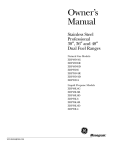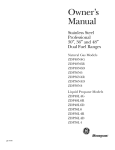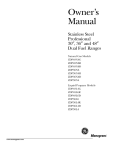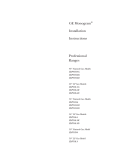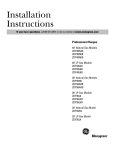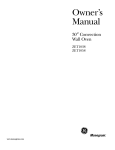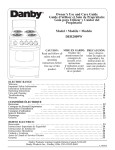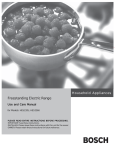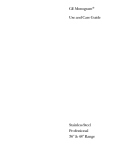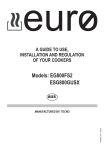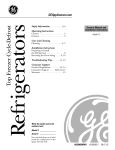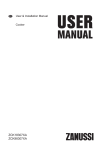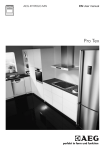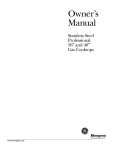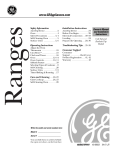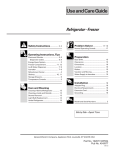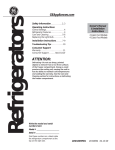Download GE Monogram ZDP48L6RWSS Gas Kitchen Range
Transcript
Owner’s Manual Stainless Steel Professional 36″ and 48″ Gas Ranges Consumer Information Stainless Steel Range Exclusive 40-point inspection Please call for your exclusive 40-Point Inspection! In the U.S.A.: 800.444.1845. In Canada: 888.880.3030. Owners of Monogram professional ranges enjoy the additional benefit of a complimentary visit by a specially trained technician. This includes temperature calibration of each oven and cooktop element. This is Monogram’s way of ensuring correct installation and precise operation of your new professional range. Our Preferred Service Specialists are always at your service. If any Monogram appliance should ever require service, please call the Monogram Preferred Service number shown above. Call anytime—24 hours a day, 7 days a week. The Monogram Preferred Service Specialist will promptly coordinate a service appointment. Contents Care and Cleaning Broiler Pan and Grid . . . . . . . . . . . . . . 27 Burner Assembly . . . . . . . . . . . . . . . . . 28 Ceramic Briquettes . . . . . . . . . . . . . . . .26 Control Panel and Knobs . . . . . . . . . . .26 Drip Trays, Drain Tubes . . . . . . . . . . . .29 Griddle . . . . . . . . . . . . . . . . . . . . . . . . . 29 Grille . . . . . . . . . . . . . . . . . . . . . . . . . . . 30 Oven Heating Elements . . . . . . . . . . . .26 Oven Light . . . . . . . . . . . . . . . . . . . . . 27 Oven Porcelain Interior . . . . . . . . . . . .30 Shelves . . . . . . . . . . . . . . . . . . . . . . 26, 30 Stainless Steel . . . . . . . . . . . . . . . . . . . .26 Consumer Services Important Phone Numbers . . . . . . . . . 33 Model and Serial Number . . . . . . . . 3, 36 Problem Solver . . . . . . . . . . . . . . . . 31, 32 Product Registration . . . . . . . . . .3, 35, 36 Safety Instructions . . . . . . . . . . . . . 2, 4–8 Warranty . . . . . . . . . . . . . . . . . . . . . . . . 34 Oven Aluminum Foil . . . . . . . . . . . . . . 6, 19, 22 Baking/Roasting . . . . . . . . . . . . . . 17–19 Broiling/Broiling Guide . . . . . . . . 22, 23 Controls . . . . . . . . . . 9, 17, 18, 21, 22, 25 Convection Cooking . . . . . . . . . . . 20, 21 Features . . . . . . . . . . . . . . . . . . . . . . . . . 9 Proofing . . . . . . . . . . . . . . . . . . . . . . . . 18 Self-Cleaning Instructions . . . . . . . 24, 25 CERTIFIED 2 ® Surface Cooking Burners . . . . . . . . . . . . . . . . . . . . . .10–11 Controls . . . . . . . . . . . . . . . . 9, 10, 13, 16 Cookware . . . . . . . . . . . . . . . . . . . . . . . .13 Features . . . . . . . . . . . . . . . . . . . . . . . . . 9 Griddle . . . . . . . . . . . . . . . . . . . . . . 15, 16 Grille . . . . . . . . . . . . . . . . . . . . . . . . 13–15 Electronic Ignitors . . . . . . . . . . . . . . . .11 Simmering . . . . . . . . . . . . . . . . . . . . . . .11 WARNING: If the information in this manual is not followed exactly, a fire or explosion may result causing property damage, personal injury or death. — Do not store or use gasoline or other flammable vapors and liquids in the vicinity of this or any other appliance. — WHAT TO DO IF YOU SMELL GAS • Do not try to light any appliance. • Do not touch any electrical switch; do not use any phone in your building. • Immediately call your gas supplier from a neighbor’s phone. Follow the gas supplier’s instructions. • If you cannot reach your gas supplier, call the fire department. — Installation and service must be performed by a qualified installer, service agency or the gas supplier. WARNING • ALL RANGES CAN TIP • INJURY COULD RESULT • INSTALL ANTI-TIP BRACKET PACKED INSIDE OVEN • SEE INSTRUCTIONS Before using your range Read this manual carefully. It is intended to help you operate and maintain your new range properly. Keep it handy for answers to your questions. If you don’t understand something or need more help, there is a list of toll-free consumer service numbers included in the back section of this manual. OR Visit our Website at: www.monogram.com Write down the model & serial numbers You’ll find them on a label in the rear of the burner box below the burner grates. Before sending in this card, please write these numbers here: These numbers are also on the Consumer Product Ownership Registration Card included in this manual. Model Number Serial Number Use these numbers in any correspondence or service calls concerning your range. If you received a damaged range Immediately contact the dealer (or builder) that sold you the range. Save time & money Before you request service, check the Problem Solver in the back of this manual. It lists causes of minor operating problems that you can correct yourself. If you need service To obtain service, see the Consumer Services page in the back of this manual. NEXT, if you are still not pleased, write all the details—including your phone number—to: We’re proud of our service and want you to be pleased. If for some reason you are not happy with the service you receive, here are the steps to follow for further help. Manager, Customer Relations GE Appliances Appliance Park Louisville, KY 40225 FIRST, contact the people who serviced your appliance. Explain why you are not pleased. In most cases, this will solve the problem. 3 IMPORTANT SAFETY INSTRUCTIONS IMPORTANT SAFETY NOTICE • The California Safe Drinking Water and Toxic Enforcement Act requires the Governor of California to publish a list of substances known to the state to cause cancer, birth defects or other reproductive harm, and requires businesses to warn customers of potential exposure to such substances. • The fiberglass insulation in self-clean ovens gives off a very small amount of carbon monoxide during the cleaning cycle. Exposure can be minimized by venting with an open window or using a ventilation fan or hood. • Gas appliances can cause minor exposure to four of these substances, namely benzene, carbon monoxide, formaldehyde and soot, caused primarily by the incomplete combustion of natural gas or LP fuels. Properly adjusted burners, indicated by a bluish rather than a yellow flame, will minimize incomplete combustion. Exposure to these substances can be minimized by venting with an open window or using a ventilation fan or hood. SAFETY PRECAUTIONS When using your appliance, follow basic safety precautions, including the following: • Have the installer show you the location of the range gas cut-off valve and how to shut it off if necessary. • Be sure all packing materials are removed from the range before operating it to prevent fire or smoke damage should the packing material ignite. • After prolonged use of a range, high floor temperatures may result and many floor coverings will not withstand this kind of use. Never install the range over vinyl tile or linoleum that cannot withstand such use. Never install it directly over interior kitchen carpeting. 4 WARNING— All ranges can tip and injury could result. To prevent accidental tipping of the range, attach it to the wall by installing the Anti-Tip device supplied. To check if the device is installed and engaged properly, carefully tip the range forward. The Anti-Tip device should engage and prevent the range from tipping over. If you pull the range out from the wall for any reason, make sure the device is properly engaged when you push the range back against the wall. • Locate the range out of kitchen traffic path and out of drafty locations and areas with poor air circulation. If it is not, there is a possible risk of the range tipping over and causing injury if you or a child stand, sit or lean on an open door. • Be sure your range is correctly adjusted by a qualified service technician or installer for the type of gas (natural or LP) that is to be used. Please refer to the Anti-Tip information in the installation instructions. WARNING: These adjustments must be made by a qualified service technician in accordance with the manufacturer’s instructions and all codes and requirements of the authority having jurisdiction. Failure to follow these instructions could result in serious injury or property damage. The qualified agency performing this work assumes responsibility for the conversion. Failure to take this precaution could result in tipping of the range and injury. SAFETY PRECAUTIONS • Use this appliance only for its intended use as described in this manual. • Be sure your appliance is properly installed and grounded by a qualified technician in accordance with the provided installation instructions. • Do not attempt to repair or replace any part of your range unless it is specifically recommended in this manual. All other servicing should be referred to a qualified technician. • Before performing any service, DISCONNECT THE RANGE POWER SUPPLY AT THE HOUSEHOLD DISTRIBUTION PANEL BY REMOVING THE FUSE OR SWITCHING OFF THE CIRCUIT BREAKER. • Do not leave children alone—children should not be left alone or unattended in an area where an appliance is in use. They should never be allowed to sit or stand on any part of the appliance. • Do not allow anyone to climb, stand or hang on the door, kick panel, drip tray handles, or cooktop. They could damage the range and even tip it over, causing severe personal injury. • Do not store flammable materials in the oven or near the cooktop. • Do not store plastic, flammable liquids or combustible materials on top of the optional high shelf. • CAUTION: ITEMS OF INTEREST TO CHILDREN SHOULD NOT BE STORED IN CABINETS ABOVE A RANGE OR ON THE BACKSPLASH OF A RANGE—CHILDREN CLIMBING ON THE RANGE TO REACH ITEMS COULD BE SERIOUSLY INJURED. • For your safety, never use your appliance for warming or heating the room. • Never wear loose-fitting or hanging garments while using the appliance. Be careful when reaching for items stored over the range. Flammable material could be ignited if brought in contact with surface burners, burner grates or oven heating elements and may cause severe burns. • Use only dry pot holders—moist or damp pot holders on hot surfaces may result in burns from steam. Do not let pot holders touch surface burners, burner grates or oven heating elements. Do not use a towel or other bulky cloth. • When surface cooking, do not touch the surface burners, burner grates, grille or griddle (on some models) or the surrounding areas. When using the oven, do not touch the oven heating elements, the interior surface of the oven or the exterior area immediately surrounding the door or back trim. These surfaces may be hot enough to burn. During and after use, do not touch, or let clothing or other flammable materials contact, the surface burners, grille or griddle (on some models), areas near the surface burners, or any interior area of the oven; allow sufficient time for cooling first. Potentially hot surfaces include the cooktop, areas facing the cooktop, oven vent opening, surfaces near the opening, crevices around the oven door, the drip tray handles directly above the oven door, metal trim parts above the door, or any backguard or high shelf surface. The drip trays get hot when the oven is on. Do not remove the drip trays until they are cool. CAUTION: The inside surface of the oven may be hot when the door is opened. • Keep the ventilator hood and grease filters clean to maintain good venting and to avoid grease fires. Turn the ventilator OFF in case of fire or when intentionally “flaming” liquor or other spirits on the cooktop. The blower, if in operation, could spread the flames. • DO NOT obstruct the flow of combustion or ventilation air to the appliance. Be sure a fresh air supply is available. • Cook meat and poultry thoroughly—meat to at least an INTERNAL temperature of 160°F. and poultry to at least an INTERNAL temperature of 180°F. Cooking to these temperatures usually protects against foodborne illness. 5 IMPORTANT SAFETY INSTRUCTIONS SAFETY PRECAUTIONS • Do not use water on grease fires. Never pick up a flaming pan. Turn the controls off. Smother a flaming pan on a surface unit by covering the pan completely with a well-fitting lid, cookie sheet or flat tray. Use a multipurpose dry chemical or foam-type fire extinguisher. Flaming grease outside a pan can be put out by covering it with baking soda or, if available, by using a multi-purpose dry chemical or foamtype fire extinguisher. Flame in the oven can be smothered completely by closing the oven door and turning the oven off or by using a multipurpose dry chemical or foam-type fire extinguisher. • DO NOT STORE OR USE COMBUSTIBLE MATERIALS, GASOLINE OR OTHER FLAMMABLE VAPORS AND LIQUIDS IN THE VICINITY OF THIS OR ANY OTHER APPLIANCE. • Do not let cooking grease or other flammable materials accumulate in or near the range. Clean drip trays and liners after every use. • If you smell gas, the installer has not done a proper job of checking for leaks. You can have a small leak and therefore a faint gas smell if the connections are not completely tight. Finding a gas leak is NOT a do-it-yourself procedure. Some leaks can only be found with the burner control in the ON position and for your protection it must be done by a qualified service technician. Never use an open flame to locate a leak. • If by some chance a burner goes out and gas escapes, open a window or a door to let the room air out. Do not attempt to use the appliance until the gas has had time to dissipate. Follow the instructions in What to do if You Smell Gas. • Do not use aluminum foil to line any part of the oven or cooktop. Using a foil liner could result in a fire hazard or the obstruction of the flow of combustion and ventilation air. Foil is an excellent heat insulator and heat will be trapped underneath it. This trapped heat can upset the cooking performance and can damage the finish of the oven or the cooktop. SURFACE COOKING • Do not heat unopened food containers; a build-up of pressure may cause the container to burst. • Set the burner control so that the flame heats only the bottom of the pan and does not extend beyond the bottom of the pan. Excessive flame is hazardous. The high BTU burners can easily melt cookware handles. • Hold the handle of the pan, using a dry pot holder, to prevent movement of the utensil when stirring or turning food. • Always heat fat slowly, and watch as it heats. • Always use the LITE position when igniting the surface burners and make sure the burners have ignited, including the center simmer flame. 6 • Never leave the surface burners unattended at high flame settings. Boilovers cause smoking and greasy spillovers that may catch on fire. If the burner flames are smothered by a severe boilover which affects the ignitor, unburned gas will escape into the room. • Do not let pot holders come near open flames when lifting cookware. Do not use a towel or other bulky cloth in place of a pot holder. • To minimize the possibility of burns, ignition of flammable materials and spillage, turn cookware handles toward the side or back of the range without extending over adjacent burners. • Never block the vents (air openings) of the range. They provide the air inlet and outlet that are necessary for the range to operate properly with correct combustion. Air openings are located at the top and bottom of the oven door, drip trays, drip tray handle areas, backgaurd vent area and area immediately surrounding the top burners (burner pans). SURFACE COOKING • Always turn the surface burners to OFF before removing cookware. • Carefully watch foods being fried at a high flame setting. • Foods for frying should be as dry as possible. Frost on frozen foods or moisture on fresh foods can cause hot fat to bubble up and over the sides of the pan. • Use the least possible amount of fat for effective shallow or deep fat frying. Filling the pan too full of fat can cause spillovers when food is added. • Use a deep fat thermometer whenever possible to prevent overheating fat beyond the smoking point. • Never try to move a pan of hot fat, especially a deep fat fryer. Wait until the fat is cool. • When using glass cookware, make sure it is designed for top-of-range cooking. • If a combination of oils or fats will be used in frying, stir together before heating or as fats melt slowly. • Do not leave any items on the cooktop. The hot air from the vent may ignite flammable items and will increase pressure in closed containers, which may cause them to burst. • Use proper pan size—avoid pans that are unstable or easily tipped. Select cookware having flat bottoms large enough to properly contain food and avoid boilovers and spillovers and large enough to cover burner grate. This will both save cleaning time and prevent hazardous accumulations of food, since heavy spattering or spillovers left on the range can ignite. Use pans with handles that can be easily grasped and remain cool. • Keep all plastics away from the top burners. • Do not leave plastic items on the cooktop— they may melt if left too close to the vent. • To avoid the possibility of a burn, always be certain that the controls for all burners are at the OFF position and all grates are cool before attempting to remove them. • When flaming foods under the hood, turn the fan on. • Grease is flammable. Let hot grease cool before attempting to handle it. Avoid letting grease deposits collect in the container under the cooktop burners, the grille or the griddle. Clean these areas after each use or boilover. • For proper lighting and performance of the cooktop burners, keep the burner ports clean. It may be necessary to clean these when there is a boilover or when the burner does not light, even though the electronic ignitors click. • After cleaning, it is important to make sure the outer cap/burner port is properly aligned with the burner base. Incorrect alignment will produce poor burner performance. Never operate the burner without all burner parts in place. • Clean the cooktop with caution. Avoid steam burns; do not use a wet sponge or cloth to clean the cooktop while it is hot. Some cleaners produce noxious fumes if applied to a hot surface. Follow manufacturer’s directions. • Do not use the grille for cooking excessively fatty meats or products which promote flare-up. • DO NOT use cookware on the grille. • If range is located near a window, do not hang long curtains that could blow over the surface burners and create a fire hazard. • Be sure all the range and/or cooktop controls are turned off and the appliance is cool before using any type of aerosol cleaner or cooking spray on or around the appliance. The chemical that produces the spraying action could, in the presence of heat, ignite or cause metal parts to corrode. 7 IMPORTANT SAFETY INSTRUCTIONS OVEN • Stand away from the range when opening the oven door. Hot air or steam which escapes can cause burns to hands, face and/or eyes. • Never “open door broil” with children nearby. They could quickly come into contact with a hot oven interior surface, causing severe burns. • Children in walkers, or children crawling, can be attracted to the round oven door handle and may grab and open the oven door. This can result in injury from the door being pulled open on a child, or severe burns if the oven is in use and hot. • Do not heat unopened food containers. Pressure could build up and the container could burst, causing an injury. • Keep the oven vent unobstructed. • Keep the oven free from grease buildup. • Place the oven shelf in the desired position while the oven is cool. If shelves must be handled when hot, do not let pot holder contact the heating elements. • Pulling out the shelf to the shelf stop is a convenience in lifting heavy foods. It is also a precaution against burns from touching hot surfaces of the door or oven walls. • When using cooking or roasting bags in the oven, follow the manufacturer’s directions. • Do not use your oven to dry newspapers. If overheated, they can catch on fire. • Do not use oven for a storage area. Items stored in an oven can ignite. • Do not leave paper products, cooking utensils or food in the oven when not in use. SELF-CLEANING OVEN • Do not clean the door gasket. The door gasket is essential for a good seal. Care should be taken not to rub, damage or move the gasket. • Before self-cleaning the oven, remove the oven shelves, oven shelf slide assemblies, broiler pan, grid and other cookware. • Do not use oven cleaners. No commercial oven cleaner or oven liner protective coating of any kind should be used in or around any part of the oven. Residue from oven cleaners will damage the inside of the oven when the selfclean cycle is used. • Be sure to wipe up excess spillage before starting the self-cleaning operation. • If the self-cleaning mode malfunctions, turn the oven off and disconnect the power supply. Have it serviced by a qualified technician. • Clean only parts listed in this Owner’s Manual. SAVE THESE INSTRUCTIONS 8 Features of Your Range Stainless Steel Range Design information (Not all features are on all models. Appearance may vary.) 11 12 9 8 14 7 10 15 13 6 12″ Oven Shelf 16 5 FRONT OFF REAR BAKE BROIL PROOF FRONT REAR OFF GRILL OVEN BAKE CONV BAKE BROIL CLEAN 17 GRIDDLE OVEN OVEN ON OVEN ON HEATING DOOR LOCKED HEATING 4 18 3 19 21 2 3 20 27″ Oven Shelf 2 23 22 1 24 25 ZDP36N4D ZDP36L4D ZDP48N4G ZDP48L4G Feature Index Page 1 12″ (small) Oven Crumb Catch Tray – 2 Oven Lights 27 3 Thermostat Bulb 4 12″ (small) Oven Control Knob 5 Cooktop Burner Control Knobs 6 12″ (small) Oven Controls 7 Burner Assemblies 10, 28 8 Model and Serial Numbers (in rear of burner box below grates—can be seen when grates are removed) 3, 36 9 Back Panel and Shelf ZDP36N4R ZDP36L4R – 17, 18, 22, 26 10, 26 17, 18, 22, 26 ZDP36N6 ZDP36L6 30 10 Grille 11 Drain Tubes 12 Griddle Flue Cover (Vent) 13 Griddle 14 Grille Control Knob 15 27″ (large) Oven Controls 16 Griddle Control Knob 17 Oven Light Switch 18 27″ (large) Oven Control Knob 19 Drip Trays 20 Broil Element 26 21 Convection Fan 20 22 Bake Element 26 23 Oven Shelf Slide Assemblies 24 24 Oven Door Gasket 8 25 Oven Door 22 13–15, 30 29 15 ZDP48N6D ZDP48L6D 15, 16, 29 13, 26 17, 21, 22, 25, 26 16, 26 – ZDP48N4G ZDP48L4G 17, 21, 22, 25, 26 13, 29 ZDP48N6R ZDP48L6R 9 Surface Cooking Stainless Steel Range Control knobs The control knobs are in front of the burner, grille or griddle they control. The oven and griddle controls are placed slightly lower than the surface burner control knobs. The surface burners have an infinite number of heat settings as there are no fixed positions between HI and LO. To turn ON a surface burner, push the control in, then turn it counterclockwise to the LITE position. Check to be sure the burner you turned on is the one you want to use. You will hear the ignitor click. When the gas is ignited all around the burner and into the central simmer burner below the simmer cap, turn the knob back to the desired setting. Push the control in and turn it counterclockwise to the LITE position. When using the simmer burner, always ensure that it lights from the main burner. Burners Your new professional gas range is equipped with burners typical of those used in restaurants. These burners are designed in two pieces for easy cleaning and control. Simmer cap Simmer burner The center, smaller cap covers and protects the simmer burner from boilovers that could put the flame out. This cap also spreads the simmer burner heat out to avoid too much heat being concentrated on the center of the pan. The simmer burner is always on when the burner is in use. The burner should never be operated if the simmer cap is not in place. The outer cap/port ring constitute the main burner and are in operation between the HI and LO settings. The burners have electronic spark ignition to eliminate continuously burning pilots. When the outer cap/port ring is on and the flame is blown out, it will relight. The burners are rated at 15,000 BTU around the outer cap/port ring. When turned to the simmer setting, only the center of the burner is lit, and it is rated at 500 BTU. 10 Outer cap/port ring Electronic ignitors NOTE: Keep the ignitor, ignitor cap and burner ports clean. Ignitor If a burner does not ignite, listen for the clicking sound. If the ignitor is not clicking, turn off the burner. Check the circuit breaker for a blown fuse or a tripped circuit breaker. If the ignitor still fails to operate, check the Problem Solver in the back of this manual or the Power Failure information in this section. NOTE: If you are using propane gas, a slight pop or flash may occur at the burner ports a few seconds after the burner has been turned off. This “extinction pop” is normal for propane gas. Burner base Simmering Your new professional gas range has exceptionally low simmering capabilities. The center simmer cap serves as a heat diffuser to spread out the heat to avoid having a center hot spot. Keep in mind that because of the high heat capacity of the outer burner, and the mass of the cast iron burner grates (they retain heat longer than lighter, conventional grates), some foods may continue to cook by retained heat after the burner has been turned off. The simmer burner is lit from the outside burner flame. Burner efficiency and flame characteristics The burner flame should burn completely around and within the burner with no excessive noise or lifting. The flame should be blue in color and stable with no yellow tips. The flame travels through the simmer ignition channels and crosses over onto the simmer burner located just beneath the simmer cap. When lighting only the simmer burner, always light the main burner first. This will in turn provide the ignition source for the simmer burner. Ensure that the simmer ports are lit before turning the control knob down to the simmer position. Should a strong draft or boilover extinguish the simmer flame, it will not relight automatically as the outer burner would. During initial use, foreign particles in the gas line, or dust in the air or around the appliance may cause an orange flame. This will disappear with use. An improper air-gas mixture may cause either a burner flutter or a yellow-tipped flame. A technician should adjust the flame. 11 Surface Cooking Stainless Steel Range Flame height The correct height of the flame mainly depends on the size of the bottom of the cooking utensil, the material of the cooking utensil, the amount and type of food and the amount of liquid in the utensil. Incorrect Correct For safe handling of cookware, never let the flame extend up the sides of the cookware. Any flame larger than the bottom of the cookware is wasted heat and only serves to heat the handle. Watch the flame, not the knob, as you reduce heat. Note: The flame size on a gas burner should match the cookware you are using. • For safety reasons the flame must never extend beyond the bottom of the cooking utensil. Never allow flames to curl up the side of the pan. • Be very careful if the pans have plastic handles, as these large professional-size burners can flame up on the outside of the pan and melt or bubble the handles. • Utensils which conduct heat slowly (such as glass-ceramic) should be used with medium to low flames. If you are cooking with a large amount of liquid a slightly larger flame can be used. Power failure 12 The electric ignition that lights the surface burners will not operate during a power failure. It is necessary to light each burner separately each time you want to use it during a power failure. To light the surface burners during a power failure, turn the control knob for the burner you want to light to LITE while holding a lighted match to the outer ring. After the flame is burning all the way around the burner, adjust the flame. The grille or griddle (on some models), or oven sections can not be used during a power failure. Cookware Do not operate a burner for an extended period of time without cookware on the grate. The finish on the grate may chip without cookware to absorb the heat. Glass: There are two types of glass cookware— those for oven use only and those for surface cooking (saucepans, coffee and teapots). Glass conducts heat very slowly. Aluminum: Medium-weight cookware is recommended because it heats quickly and evenly. Most foods brown evenly in an aluminum skillet. Use saucepans with tightfitting lids for cooking with minimum amounts of water. Heatproof Glass-Ceramic: Can be used for either surface or oven cooking. It conducts heat very slowly and cools very slowly. Check cookware manufacturer’s directions to be sure it can be used on gas cooktops. Cast Iron: If heated slowly, most skillets will give satisfactory results. Enamelware: Under some conditions, the enamel of some cookware may melt. Follow cookware manufacturer’s recommendations for cooking methods. Stainless Steel: This metal alone has poor heating properties, and is usually combined with copper, aluminum or other metals for improved heat distribution. Combination metal skillets generally work satisfactorily if they are used at medium heat as the manufacturer recommends. Wok: A large, professional-sized wok and wok ring, specially designed for use on this range, is available from your dealer. Ask for model ZXWK22Y. Using the grille (on some models) Before starting to cook on the grille, be sure the drip tray and liners are in place and that you have the grille racks turned to the side you want for cooking. Preheat the grille for 15 minutes with the control knob set on HI. When the grille is preheated, place the food on the grille. Cook it to the desired doneness. NOTE: The longer you preheat the grille, the darker the grille marks will be on your food. During cooking it may be necessary to adjust the heat setting. The control knob may be set to any position between HI and LO. For proper searing and browning the grille requires high heat. With large pieces of meat or poultry you will need to turn the heat to a lower heat setting after the food has been seared. This lower heat setting will allow the food to cook through without burning the outside. Marinades and barbecue sauce should be added toward the end of cooking time. The heat should be turned to low when sauces are added. Do not leave the grille unattended while it is on. When you are finished cooking, allow the grille and the drip trays to cool before cleaning them. They should be cleaned each time they are used. 13 Surface Cooking Stainless Steel Range Excessive grille flareups and flaming Occasionally grease drippings ignite. These drippings will create minor puffs of flame for a second or two. This is normal when cooking on a barbecue. You may find it handy to have a spray bottle filled with water to lightly spray the flare-up. If the flame becomes excessive, remove the food from the grille. Lower the heat setting. Replace the food when the flare-up subsides. Grille rack To prevent flare-ups from happening, trim the fat from around the edges of steaks and chops, use hamburger that is lean, remove the fat from poultry, etc. When turning any kind of meat or poultry, the melting fat will drop onto the briquettes and it may create a flare-up. If this happens, use a long-handled spatula to move the food to another area. The two-piece rack is reversible. Place the side with the two grooved tabs toward the back of the cooktop. The grille rack is made of cast Type 304 stainless steel. The rack will change color when subjected to the heat of the grille, and as oils cook onto the surface. This is normal and does not affect the cooking performance of the grille. For best results, the rack should be seasoned before the first use. Seasoning will insure a stick-resistant cooking surface. If the grille has not been used for a period of time, it should be reseasoned. To season the grill rack: 1 Clean the rack thoroughly with hot, soapy water to remove any manufacturing oils, etc. 2 Rinse with a mixture of 2 cups water and 1/2 cup white vinegar. Dry thoroughly. 3 Using a heavy cloth, rub vegetable oil over the entire surface of the rack. Do not use corn oil, as it gets sticky. 4 Place rack into the grille housing. Turn the burner on to a medium setting. Turn the burner off when the oil begins to smoke. Allow rack to cool. 5 Repeat steps 3 and 4. 6 Using a heavy cloth, apply a very thin layer of vegetable oil over the entire cooking surface. The grille is now ready for use. One side of the grille (side A) is ridged and should be used for foods where you want the fat to run off, such as steak or hamburger patties. The ridges are sloped so the fat runs toward the front of the grille and can easily run down to the cooler area of the drip tray and away from the intense heat of the burner. 14 Side A Side B The other side of the grille (side B) was designed for foods that need more support while cooking, such as fish. Food cooked on this grille achieves the same flavor as food cooked on an outdoor grille. The intense radiant heat from the ceramic briquettes caramelizes the fats and juices that are brought to the surface of the food, giving it the barbecued flavor. This gas grille may cook slightly faster than you are used to. Grilling hints • When turning the meat over, always use a spatula as it will not puncture the meat allowing the juices to run out. This will help to keep the meat juicy. Turn the meat only once, as juices are lost when the meat is repeatedly turned. Season or salt the meat after it has been cooked; these procedures have a tendency to dry the meat out. • Be sure to trim any excess fat from meat or poultry. To prevent steaks or chops from curling while they are being cooked, slit the fat around the edges at about 2″ intervals. To test for doneness, make a small cut in the center of the meat. Before using the griddle (on some models) The built-in griddle is made from Type 304 stainless steel, highly polished to provide a smooth cooking surface. It is normal for it to darken with use as oils cook onto the surface to provide a stick-resistant base or “seasoning.” Since the griddle is made from stainless steel, the surface will not rust. • The doneness of meat is affected by the thickness of the cut. It is impossible to cook a thin piece of meat to a rare doneness. A steak should be at least 1″ thick to have it turn out rare and juicy. The cooking time is affected by the temperature of the meat when you start to cook it, the size and shape of the cut and the kind of meat you are cooking. The degree of doneness desired also affects the time. • The U. S. Department of Agriculture says, “Rare beef is popular, but you should know that cooking it to only 140°F. means some food poisoning organisms may survive.” (Source: Safe Food Book. Your Kitchen Guide. USDA Rev. June 1985.) Shipping screw Outer leveling screws Remove the center shipping screw. Leave the two outer leveling screws in place. Griddle flue cover The griddle is thermostatically controlled and cycles on and off to maintain the set temperature. The “HEATING” light indicates that the burner is on. The griddle assembly is not to be removed for cleaning and is held in place by three rear screws. These screws keep the griddle from shifting in transit, and are also used for positioning to avoid breaking ignition components. Once the unit is in position, the rear center shipping screw can be removed. It is located beneath the griddle flue cover. Remove the flue cover by lifting it straight up. Be careful not to scratch the backguard during removal of the flue cover. The two outer screws are leveling screws. Do not remove these two screws. They can be turned to level the griddle or to provide a forward slope to help grease and oils to drain away from the food being cooked. After using the griddle a few times you will be able to judge the slope best for the foods you are cooking and your personal preference. When replacing the griddle flue cover, ensure that the cover slips to the outside of the front and back metal flanges of the fixed griddle assembly. This will ensure a tight fit of the flue cover. 15 Surface Cooking Stainless Steel Range Seasoning the griddle Before using the griddle for the first time, it must be seasoned. If the griddle has not been used for a period of time, it should be reseasoned. To season the griddle: 1 Clean the griddle thoroughly with hot, soapy water to remove any protective coating. 2 Rinse with a mixture of 1 quart water and 1 cup white vinegar. Dry thoroughly. 4 Turn the control knob to a medium setting (350°F.). Turn the heat off when the oil begins to smoke. Allow the griddle to cool. 5 Repeat step 3. Be sure to cover the entire surface with the oil. 6 Repeat step 4. Allow the griddle to cool. Wipe the entire surface of the griddle using a heavy cloth. Apply a very thin layer of vegetable oil. The griddle is now ready to use. 3 Pour 1 teaspoon vegetable oil into the center of the griddle. Do not use corn oil as it gets sticky. Rub the oil over the entire surface of the griddle using a heavy cloth. Using the griddle 16 Before starting to cook on the griddle, be sure the drip tray and liners are in place. Select the cooking temperature and preheat for 15 minutes. When the griddle is preheated, the HEATING light will turn off. Place the food on the griddle and cook to the desired doneness. NOTE: When the griddle is properly seasoned, it can be used without any additional shortening. However, shortening can be used for flavor. Using the Ovens Stainless Steel Range Oven shelves To avoid possible burns, place the shelves in the correct position before you turn the oven on. The correct shelf position depends on the kind of food and the browning desired. The shelves have stop-locks, so that when placed correctly on the supports, they will stop before coming completely out, and will not tilt. When placing and removing cookware, pull the shelf out to the bump on the shelf support. To remove a shelf, pull it toward you, tilt the front end up and pull it out. To replace, place the end of the shelf (stoplocks) on the support, tilt up the front and push the shelf in. The oven has 3 shelf positions. How to set the ovens for baking or roasting 12″ oven control (48″ ranges only) 27″ oven control 1 Push in the BAKE selector button on the side of the control panel above the oven you wish to use. 2 Using the thermostat dial, set the desired temperature. • The OVEN ON light turns on and remains on until the OFF selector button has been pushed or the thermostat dial has been turned to the OFF position. C • The HEATING light turns on. Once the HEATING light initially cycles off, the oven is preheated. A 3 Check the food for doneness at the minimum time on the recipe. Cook longer if necessary. B When roasting, use the A or B shelf position. 4 Push in the OFF selector button on the side of the control panel above the oven you are using when baking is finished. NOTE: When roasting, check the weight of the meat. Place the meat fat side up, or for poultry, breast side up, on the roasting grid in a shallow pan. The melting fat will baste the meat. Select a pan as close to the size of the meat as possible. (The broiler pan with grid is a good pan for this.) 17 Using the Ovens Stainless Steel Range How to set the 12 ″ oven for proofing The proofing feature maintains a warm, non-drafty environment useful for proofing yeast-leavened products. (48 ″ ranges only) 2 Push in the PROOF selector button on the left hand side of the control panel above the thermostat dial. 1 Place the dough in a dish in the small oven. • The OVEN ON light and oven interior light turn on. • The HEATING light will not turn on. • The thermostat dial does not affect the proof temperature. 3 Set a minute timer for the minimum proof time. When proofing is finished, push the OFF selector button. • To avoid lowering the oven temperature and lengthening proofing time, do not open the oven door unnecessarily. Proofing time may be decreased when you use the large oven at the same time you are proofing. Check bread products early to avoid overproofing. For optimum results, if you are using the large oven for extended periods of time, it is recommended that you complete the proofing before turning the large oven on. NOTE: Do not use the proofing mode for warming food or keeping food hot. The proofing oven temperature is not hot enough to hold foods at safe temperatures (above 140°F.). 18 12″ oven control Baking pans/sheets Use the proper baking pan. The type of finish on the pan determines the amount of browning that will occur. • Dark, rough or dull pans absorb heat resulting in a browner, crisper crust. Use this type for pies. Pan placement For even cooking and proper browning, there must be enough room for air circulation in the oven. Baking results will be better if baking pans are centered as much as possible rather than being placed to the front or to the back of the oven. • Shiny, bright and smooth pans reflect heat, resulting in a lighter, more delicate browning. Cakes and cookies require this type of pan or sheet. • Glass baking dishes also absorb heat. When baking in glass baking dishes, the temperature may need to be reduced by 25°F. If you need to use two shelves, stagger the pans so one is not directly above the other. Check the food on the bottom shelf sooner than the minimum time. The food on the lower shelf may cook slightly faster than the food on the upper shelf. Pans should not touch each other or the walls of the oven. Allow 1- to 11⁄2″ space between pans as well as from the back of the oven, the door and the sides. Preheating Preheat the oven if the recipe calls for it. To preheat, set the oven at the correct temperature—selecting a higher temperature does not shorten preheat time. Aluminum foil Never entirely cover a shelf with aluminum foil. This will disturb the heat circulation and result in poor baking. A smaller sheet of foil may be used to catch a spillover by placing it on a lower shelf several inches below the food. Preheating is necessary for good results when baking cakes, cookies, pastry and breads. 19 Using the Ovens Stainless Steel Range What is convection cooking? In a convection oven, a fan circulates the heated air evenly, over and around the food. This circulating hot air is evenly distributed throughout the oven cavity. As a result, foods are evenly cooked and browned—often in less time with convection heat. Preheating is not necessary with foods having a bake time of over 15 minutes. • Food is heated faster in a convection oven. When using the convection feature, many types of food can be cooked at lower temperatures than those suggested for regular ovens. • Good for large quantities of baked foods. • Good results with cookies, biscuits, brownies, cream puffs, sweet rolls, angel food cake and bread. • Ideal for baked foods cooked on two or three shelves. Because heated air is circulated evenly throughout the oven, foods can be baked with excellent results on two or three shelves at a time. Multi-shelf baking may increase cook times slightly for some foods, but the overall result is time saved. Multi-shelf baking provides very good results with cookies, biscuits and other quickbreads. • Recipe books often give times and temperatures for cooking in regular ovens. Convection ovens make it possible to reduce the temperature by 25°F. • Check foods for doneness at the minimum suggested cooking time. • Some package instructions for frozen casseroles or main dishes have been developed using commercial convection ovens. For best results in this oven, preheat the oven and use the temperature on the package. 20 How to set the 27 ″ oven for convection baking 1 Push in the CONV. BAKE selector button on the right hand side of the control panel above the thermostat dial (close to the center on 36″ ranges). 2 Using the thermostat dial, set the desired temperature. • The OVEN ON light turns on and remains on until the OFF selector button has been pushed or the thermostat dial has been turned to the OFF position. 27″ oven control • The HEATING light turns on. Once the HEATING light initially cycles off, the oven is preheated. 3 Check the food for doneness at the minimum time on the recipe. Cook longer if necessary. 4 Push in the OFF selector button on the right hand side of the control panel above the thermostat dial when convection baking is finished. Convection cookware Before using your convection oven, check to see if your cookware leaves room for air circulation in the oven. If you are baking with several pans, leave space between them. Also, be sure the pans do not touch each other or the walls of the oven. Use the pan size recommended in the recipe. When baking cookies, you will get the best results if you use a flat cookie sheet instead of a pan with low sides. For recipes like oven-baked chicken, you should use a pan with low sides. Hot air cannot circulate well around food in a pan with high sides. Metal and Glass Any type of cookware will work in your convection oven. However, metal pans heat the fastest and are recommended for convection baking. • Darkened or matte-finished pans will bake faster than shiny pans. • Glass or ceramic pans cook more slowly. Paper and Plastic Heat-resistant paper and plastic containers that are recommended for use in regular ovens can be used in convection ovens. Plastic cookware that is heat-resistant to temperatures of 400°F. can also be used. 21 Using the Ovens Stainless Steel Range How to set the ovens for broiling 12″ oven control (48″ ranges only) 27″ oven control 1 If the meat has fat or gristle around the edge, cut vertical slashes through both about 2″ apart. If desired, the fat may be trimmed, leaving a layer about 1/8″ thick. 2 Place the meat or fish on the broiler grid in the broiler pan. Always use the grid so that any fat will drip into the broiler pan; otherwise the juices may become hot enough to catch on fire. Leave the door open to the broil stop position. 3 Position a shelf on the recommended shelf position as suggested in the Broiling Guide. 4 Leave the door open to the broil stop position. The door stays open by itself, yet the proper temperature is maintained in the oven. 5 Push in the BROIL selector button on the side of the control panel above the oven you wish to use. NOTE: A cooling fan will be activated when the BROIL selector button is pushed. This cooling fan cools the oven controls when open door broiling. Use caution when reaching into the oven during open door broiling as drip tray handles may be hot. 6 Turn the control knob below the selector button to BROIL. Aluminum foil 22 You can use aluminum foil to line the broiler pan and broiler grid. However, you must mold the foil tightly to the grid and cut slits in it just like the grid. The broiler does not need to be preheated for most broiling. However, foods that cook quickly, such as thin strips of meat or fish may require a short preheating period of 2 to 3 minutes to allow the food surface to brown in the same time the food takes to be cooked throughout. Turn the food only once during broiling. Time the foods for the first side according to the Broiling Guide. 7 When broiling is finished, push in the OFF selector button. Broiling guide Suggested shelf positions and cooking times are intended as general guidelines only. Experiment with these settings for specific foods and your personal preference. Shelf Position C 1st Side Minutes 3–5 2nd Side Minutes 3–5 2 lbs. (8 patties) 1/2 to 3/4″ thick B 10–13 7–10 Space evenly. Up to 8 patties take about the same time. 1″ thick (1 to 11⁄2 lbs.) B B B 7 8–10 20–25 7 6–9 15 Steaks less than 1″ thick cook through before browning. Pan frying is recommended. Rare Medium Well Done 11⁄2″ thick (2 to 21⁄2 lbs.) B B A 10 15 25 7–8 14–16 20–25 Slash fat. Chicken 1 whole (2 to 21⁄2 lbs.), split lengthwise A 30–35 25–30 Reduce time about 5 to 10 minutes per side for cut-up chicken. Brush each side with melted butter. Broil skin-sidedown first. 2 to 4 slices 1 pkg. (2) 2 (split) C C C 11⁄2–2 11⁄2–2 4–6 1/2 1/2 Space evenly. Place English muffins cutside-up and brush with butter, if desired. Lobster Tails 2–4 (6 to 8 oz. each) B 14–18 Do not turn over. Cut through back of shell. Spread open. Brush with melted butter before broiling and after half of broiling time. Fish 1-lb. fillets 1/4 to 1/2″ thick B 8–10 5–10 Handle and turn very carefully. Brush with lemon butter before and during cooking, if desired. Preheat broiler to increase browning. Ham Slices (precooked) 1″ thick B 9 8–10 Increase time 5 to 10 minutes per side for 11⁄2″ thick or home cured. Pork Chops Well Done 2 (1/2″ thick) 2 (1″ thick), about 1 lb. B B 15 15–20 10–15 15–18 Slash fat. Lamb Chops Medium Well Done 2 (1″ thick), 10 to 12 oz. B B 8–10 12–15 4–7 8–10 Slash fat. Medium Well Done 2 (11⁄2″ thick), about 1 lb. B B 10–13 17 10–12 12–14 Wieners, Sausages, Bratwurst 1-lb. pkg. (10) B 6–8 1–4 Food Bacon Ground Beef Well Done Beef Steaks Rare Medium Well Done Bakery Products Bread (Toast) Toaster Pastries English Muffins Quantity/ Thickness 1/2 lb. (about 8 thin slices) Comments Arrange in single layer. If desired, split in half lengthwise; cut into 5 to 6″ pieces. 23 Self-Cleaning 27″ Oven Stainless Steel Range Before a clean cycle NOTE: When the 27″ oven is set for selfcleaning, only the surface burners may be used. The 12″ oven, the griddle and/or the grille cannot be used. The range must be completely cool in order to set the self-clean cycle. We recommend venting with an open window or using a ventilation fan or hood during the first self-clean cycle. Oven shelf slide assembly An interlock system has been designed so that the self-clean cycle will not start until the shelf slide assemblies have been removed. Remove all cookware and any aluminum foil from the oven. Remove the oven shelves and shelf slide assembly. Make sure the oven light bulb cover is in place and the oven light is off. Do not use commercial oven cleaners or oven protectors in or near the self-cleaning oven. Lift up and off U-Shaped bracket The roller-assisted shelf supports are designed to withstand standard baking temperatures. Push rod They will not withstand the extreme temperatures of self-cleaning. Retaining screw To remove the slide assemblies: 1 Loosen the retaining screws on both sides of the oven. 2 Lift up slightly and pull the entire assembly out. Set aside. To replace the slide assemblies: When self-cleaning is finished, and the oven has cooled, replace the assemblies and retaining screws. Bottom bracket 1 Guide the rear of the shelf slide assembly into the bottom rear bracket. 2 Guide the top rear of the shelf slide assembly into the top “U”-shaped bracket. 3 Lift up the push rod so that it rests on the ledge of the side support of the assembly. 4 Reattach the assembly securely to the oven with the retaining screw. Repeat for the other side of the oven. Pull the entire assembly out. 24 Push up here How to set the 27 ″ oven for self-cleaning The clean cycle takes about 5 hours plus about 30 minutes to cool down. 1 Push in the CLEAN selector button on the right hand side of the control panel above the thermostat dial. 2 Set the thermostat dial to CLEAN. • Cooling blower turns on. • The OVEN ON light and HEATING light turn on. 27″ oven control • The DOOR LOCKED light turns on. 3 When cleaning has finished, push the OFF selector button. The blower and the OVEN ON light will turn off once the cycle has finished. The door latch will open automatically after the oven temperature falls below 550°F. After a clean cycle If white spots remain, remove them with warm sudsy water and rinse thoroughly with a vinegar and water mixture. These deposits are usually a salt residue that cannot be removed by the clean cycle. If the oven is not clean after one clean cycle, repeat the cycle. You may notice some white ash in the oven. Wipe it up with a damp cloth after the oven cools. 25 Care and Cleaning Stainless Steel Range Control panel and knobs Clean up spatters with a damp cloth. Remove heavier soil with warm, soapy water. Do not use abrasives of any kind on the control panel. The control knobs may be removed for easier cleaning. To remove a knob, pull it straight off the stem. Wash the knobs in soap and water but do not soak. Oven heating elements Do not clean the bake elements or the broil elements. Any soil will burn off when the elements are heated. Oven shelves Clean the shelves with an abrasive cleanser or steel wool. After cleaning, rinse the shelves with clean water and dry with a clean cloth. Ceramic briquettes The layer of ceramic briquettes, under the grille racks, will last for many years with proper care. Burned-on food particles and ash can be emptied off the radiant tray when cool by shaking over a waste receptacle. Stainless steel Do not use a steel-wool pad; it will scratch the surface. To clean the stainless steel surface, use a hot, damp cloth with a mild detergent suitable for stainless steel surfaces. Use a clean, hot, damp cloth to remove soap. Dry with a dry, clean cloth. If food soil remains, try a general kitchen cleaner, such as Fantastik®, Simple Green® or Formula 409®. For hard-to-clean soil, use a standard stainless steel cleaner, such as Bon-Ami® or Cameo®. 26 The bake elements can be lifted gently to clean the oven floor. If spillovers, residue or ash accumulate around the bake elements, gently wipe around the element with warm water. Chipping or cracking of the briquettes may occur as they may get brittle with age, depending on the frequency of use. This is normal and does not affect the performance. Do not replace the radiant tray/briquettes with alternates. Apply cleaner with a damp sponge. Use a clean, hot, damp cloth to remove cleaner. Dry with a dry, clean cloth. Always scrub lightly in the direction of the grain. After cleaning, use a stainless steel polish such as Stainless Steel Magic®, Revere Copper and Stainless Steel Cleaner®, or Wenol All Purpose Metal Polish®. Follow the product instructions for cleaning the stainless steel surface. Oven light NOTE: The glass cover should be removed only when cold. Wearing latex gloves may offer a better grip. The light bulb is located on the back of the oven. Before replacing the bulb, disconnect electrical power to the range at the main fuse or circuit breaker panel. Socket Bulb 31⁄2″ Max. length Let the bulb cool completely before removing it. For your safety, do not touch a hot bulb with a damp cloth. If you do, the bulb will break. To remove: Turn to remove the cover, then remove the bulb. Glass cover To replace: Put in a new 40-watt appliance bulb. A 40-watt appliance bulb is smaller than a standard 40-watt household bulb. Install and tighten the cover. Reconnect electrical power to the range. Broiler pan and grid After broiling, remove the broiler pan from the oven. Remove the grid from the pan. Carefully pour out the grease from the pan into a proper container. Wash and rinse the broiler pan and grid in hot water with a soap-filled or plastic scouring pad. If food has burned on, sprinkle the grid with detergent while hot and cover with wet paper towels or a dishcloth. Soaking the pan will remove burned-on foods. The broiler pan may be cleaned with a commercial oven cleaner. The grid is chrome; do not use an oven cleaner to clean it. Both the broiler pan and grid can also be cleaned in the dishwasher. Do not store a soiled broiler pan and grid anywhere in the range. 27 Care and Cleaning Stainless Steel Range Burner assembly The burner assemblies should be washed regularly and, of course, after spillovers. Turn all the controls to OFF before removing the burner parts. The electrode of the spark ignitor is exposed beyond the top of the burner. When cleaning the burner tray, be careful not to snag the electrode of the spark ignitor with your cleaning cloth. Do not hit the spark ignitor. Be careful not to turn on any surface controls while cleaning the burner tray. A slight electrical shock might result which could cause you to knock over hot cookware. The burner grates and burner caps can be lifted off, making them easy to clean. Removing them gives you access to the burner bases. To avoid snagging cloth on spark ignitors, leave burner caps in place when cleaning the burner tray. The burners have been designed in two pieces for ease of cleaning. When the burner grate and the burner are cool, remove the grate. The burner caps can easily be lifted off. Wash these parts in hot soapy water, rinse and dry thoroughly. A bristle brush can be used to clean out the burner ports, if necessary. The burner grates are porcelain enamel. When cool, they may be wiped clean using hot, soapy water, then rinsed and wiped dry. When lifting the burner grates, be careful as they are heavy. Place them on a protected surface, so they won’t scratch the surface of the cooktop. 28 Ignitor Simmer cap Outer cap/ burner ports Burner base Locating pin CAUTION: Do not operate the burner without all burner parts in place. After cleaning, it is important to make sure the indentation on the bottom side of the outer cap/burner port is properly aligned with the corresponding locating pin in the burner base. Incorrect alignment will produce poor burner performance. Drip trays, drip tray liners and drain tubes Located beneath the cooktop are one or two drip trays. If you have a griddle or a grille there will also be a tray liner. The drip trays and liners are made of stainless steel. The drip trays are on rollers so they are easy to remove and replace. To remove the drip tray, pull it forward. If something has spilled into the tray, it should be cleaned up as soon as possible to prevent “baked on” food soil. Drain tubes OFF BAKE CONV BAKE BROIL CLEAN OVEN OVEN ON HEATING DOOR LOCKED Drip tray and liner Grease from the griddle or the grille drains through the drain tubes into the tray and into the liner below. Do not allow the grease to accumulate in the drip tray or liner as it can be a fire hazard. Clean the drip tray and liner as soon as they are cool. Clean with hot soapy water. To clean the drain tube use a soapy bottle brush. A mild abrasive cleaner such as Bon-Ami® or Soft Scrub® can be used. For stubborn stains, use a soap-filled steel wool pad or a harsh abrasive cleaner such as Comet® or Ajax®, rubbing lightly. Rinse all parts thoroughly. Griddle (on some models) Thoroughly clean the griddle of grease and food particles, using a square-edged spatula, while it is still hot. Wipe the griddle with a dry, heavy, coarse cloth to remove any remaining residue and food particles. Wash with hot soapy water, rinse and dry. Once the griddle has cooled, rub the surface lightly with vegetable oil. Do not use corn oil or cooking sprays as they get sticky. If the griddle is cleaned with anything other than a dry, heavy, coarse cloth, it will need to be reseasoned. Never flood the hot griddle with cold water. This could cause the griddle to crack or warp. 29 Care and Cleaning Stainless Steel Range Grille (on some models) Clean the grille immediately after cooking. Turn off the burner. To protect your hand from steam and heat, wear a barbecue mitt. Scrub the grille by dipping a brass bristle barbecue brush frequently into a bowl of water. The steam created softens the food particles and assists the cleaning process. The food particles will drop into the drip tray or into the radiant tray holding the ceramic briquettes. Be sure to clean the drain tube, drip tray and liner after they have cooled. Back panel and shelf The back panel and shelf are made of stainless steel. Do not use a steel-wool pad; it will scratch the surface. Clean with hot soapy water. Rinse and dry. If the panel and shelf have food soil remaining, try a general kitchen cleaner, such as Fantastik®, Simple Green® or Formula 409®. 12 ″oven porcelain interior (48 ″ ranges only) With proper care, the porcelain enamel finish on the inside of the oven—top, bottom, sides, back and inside of the door—will stay newlooking for years. Let the range cool before cleaning. We recommend that you wear rubber gloves when cleaning the range. Soap and water will normally do the job. Heavy spattering or spillovers may require cleaning with a mild abrasive cleaner. Soapy, wet metal pads may also be used. Do not allow food spills with a high sugar or acid content (such as milk, tomatoes, sauerkraut, fruit juices or pie filling) to remain on the surface. They may cause a dull spot even after cleaning. Household ammonia may make the cleaning job easier. Place 1/2 cup in a shallow glass or pottery container in a cold oven overnight. The ammonia fumes will help loosen the burned-on grease and food. 30 For hard to clean soil use a standard stainless steel cleaner such as Bon-Ami®, Cameo® or Bar Keepers Friend®. Apply cleaner with a damp sponge, rinse thoroughly and dry. Always scrub lightly in the direction of the grain. After cleaning, use a stainless steel polish such as Stainless Steel Magic®. If necessary, you may use an oven cleaner. Follow the package directions. Cautions about using spray-on oven cleaners: • Do not spray on the electrical controls and switches because it could cause a short circuit and result in sparking or fire. • Do not allow a film from the cleaner to build up on the temperature sensor—it could cause the oven to heat improperly. (The sensor is located at the top of the oven.) Carefully wipe the sensor clean after each oven cleaning, being careful not to move the sensor as a change in its position could affect how the oven bakes. • Do not spray any oven cleaner on the oven door, handles or any exterior surface of the oven, cabinets or painted surfaces. The cleaner can damage these surfaces. The Problem Solver Stainless Steel Range Questions? Use this problem solver! PROBLEM POSSIBLE CAUSE SURFACE BURNERS DO NOT LIGHT • Burners assembled incorrectly after cleaning. Make sure the burner assembly is put together correctly and that the outer caps/burner ports are aligned. • Ports blocked in the outer cap near the ignitor. Clean and reassemble. See “Burner assembly” in the Care and Cleaning section. • Inspect the manual cut-off valve to insure that it is not closed. • Make sure the electrical plug is plugged into a live power outlet. • Check for a power outage. SURFACE BURNER FLAMES VERY LARGE OR YELLOW • Improper air/gas ratio in burners. Call for service. TICKING SOUND OF SPARK IGNITOR AFTER SURFACE BURNER LIGHTS • The spark ignitor is not deactivated. Turn the burner OFF and relight. Some ticking is normal. If ticking is excessive, call for service. STRONG ODOR FROM • Improper air/gas ratio in surface burners. Call for service. SURFACE BURNERS OVEN LIGHT DOES NOT WORK • The light bulb is loose or defective. Tighten or replace the bulb. FOOD DOES NOT BAKE OR ROAST PROPERLY • The oven controls are improperly set. See the “How to set your oven for baking or roasting” section. • The switch operating light is broken. Call for service. • Incorrect cookware or cookware of improper size being used. See the “How to set your oven for baking or roasting” section. • Use a foil tent to slow down browning during roasting. FOOD DOES NOT BROIL PROPERLY • The oven control is not set at BROIL. Push in the BROIL selector button for the oven you want to use. • The oven door is not open to the broil stop position as recommended. • Improper shelf position being used. See the Broiling Guide. • Food is being cooked in a hot pan. • Cookware is not suited for broiling. Use the broiling pan and grid that came with your range. • Aluminum foil used on the broiling pan and grid has not been fitted properly and slit as recommended. • In some areas the power (voltage) may be low. Preheat the broil element for 10 minutes. Broil for the longest period of time recommended in the Broiling Guide. 31 The Problem Solver Stainless Steel Range Questions? Use this problem solver! PROBLEM POSSIBLE CAUSE OVEN WILL NOT WORK • Plug on the range is not completely inserted in the electrical outlet. • A fuse in your home may be blown or the circuit breaker tripped. • The oven controls are not properly set. • The oven controls are set for cleaning. If necessary, allow the oven to cool then open the door. OVEN WILL NOT SELF-CLEAN • The oven temperature is too high to set a self-clean operation. Allow the range to cool to room temperature and reset the controls. • The controls are not properly set. • The self-clean cycle will not start until the shelf slide assemblies have been removed. UNABLE TO USE THE 12 ″ OVEN, GRIDDLE AND/OR GRILLE WHEN SELF-CLEANING • When the 27″ (large) oven is set for cleaning, only the surface burners may be used. The 12″ (small) oven, the griddle and/or the grille cannot be used. “CRACKING” OR “POPPING” SOUND DURING CLEANING • This is normal. This is the sound of the metal heating and cooling during both the cooking and cleaning functions. EXCESSIVE SMOKING • Excessive soil. Press the OFF selector button. Open the windows to OCCURS DURING rid the room of smoke. Wait until the DOOR LOCKED light goes CLEANING off. Wipe up excess soil and reset the clean cycle. STRONG ODOR FROM • An odor from the insulation around the inside of the oven is normal SELF-CLEAN CYCLE for the first few times the oven is used. This is temporary. OVEN NOT CLEAN AFTER A CLEAN CYCLE 32 • The oven was heavily soiled. Clean up heavy spillovers before starting the clean cycle. Heavily soiled ovens may need to self-clean again. • The oven controls are not properly set. See the Self-Cleaning section. Consumer Services With the purchase of your new Monogram appliance, receive the assurance that if you ever need information or assistance from GE, we’ll be there. All you have to do is call—toll- free! GE Answer Center® 800.626.2000 Whatever your question about any Monogram major appliance, GE Answer Center® information service is available to help. Your call—and your question—will be answered promptly and courteously. And you can call any time. GE Answer Center® service is open 24 hours a day, 7 days a week. OR Visit our Website at: www.monogram.com In-Home Repair Service In the U.S.A.: 800.444.1845 A GE consumer service professional will provide expert repair service, scheduled at a time that’s convenient for you. Many GE Consumer Service company-operated locations offer you service today or tomorrow, or at your convenience (7:00 a.m. to 7:00 p.m. weekdays, 9:00 a.m. to 2:00 p.m. Saturdays). Our factory-trained technicians know your appliance inside and out—so most repairs can be handled in just one visit. In Canada: 888.880.3030 For Customers With Special Needs… 800.626.2000 Service Contracts 800.626.2224 GE offers, free of charge, a brochure to assist in planning a barrier-free kitchen for persons with limited mobility. Consumers with impaired hearing or speech who have access to a TDD or a conventional teletypewriter may call 800.TDD.GEAC (800.833.4322) to request information or service. You can have the secure feeling that GE Consumer Service will still be there after your warranty expires. Purchase a GE contract while your warranty is still in effect and you’ll receive a substantial discount. With a multiple-year contract, you’re assured of future service at today’s prices. Parts and Accessories Individuals qualified to service their own appliances can have parts or accessories sent directly to their home. The GE parts system provides access to over 47,000 parts…and all GE Genuine Renewal Parts are fully warranted. VISA, MasterCard and Discover cards are accepted. 800.626.2002 User maintenance instructions contained in this manual cover procedures intended to be performed by any user. Other servicing generally should be referred to qualified service personnel. Caution must be exercised, since improper servicing may cause unsafe operation. 33 WARRANTY YOUR MONOGRAM RANGE WARRANTY Staple sales slip or cancelled check here. Proof of original purchase date is needed to obtain service under warranty. WHAT IS COVERED FULL ONE-YEAR WARRANTY For one year from date of original purchase, we will provide, free of charge, parts and service labor in your home to repair or replace any part of the range that fails because of a manufacturing defect. LIMITED FIVE-YEAR WARRANTY For five years from the date of original purchase, we will provide, free of charge, replacement gas surface burners if they fail in normal household use. (The grille, griddle and oven burners are not included.) You pay for the service trip to your home and all service labor charges. WHAT IS NOT COVERED • Service trips to your home to teach you how to use the product. • Discoloration of the griddle plate. • Chipping of porcelain enamel grates. • Replacement of house fuses or resetting of circuit breakers. • Incidental or consequential damage caused by possible defects with this appliance. This warranty is extended to the original purchaser and any succeeding owner for products purchased for ordinary home use in the 48 mainland states, Hawaii and Washington, D.C. In Alaska the warranty is the same except that it is LIMITED because you must pay to ship the product to the service shop or for the service technician’s travel costs to your home. All warranty service will be provided by our Factory Service Centers or by our authorized Customer Care® servicers during normal working hours. Should your appliance need service, during warranty period or beyond, in the U.S.A. call 800.444.1845. In Canada: 888.880.3030. • Damage to the product caused by accident, fire, floods or acts of God. • Failure of the product if it is used for other than its intended purpose or used commercially. • Improper installation. If you have an installation problem, contact your dealer or installer. You are responsible for providing adequate electrical, gas, exhausting and other connecting facilities as described in the Installation Instructions provided with the product. Some states do not allow the exclusion or limitation of incidental or consequential damages, so the above limitation or exclusion may not apply to you. This warranty gives you specific legal rights, and you may also have other rights which vary from state to state. To know what your legal rights are in your state, consult your local or state consumer affairs office or your state’s Attorney General. Warrantor: General Electric Company. If further help is needed concerning this warranty, write: Manager—Customer Relations, GE Appliances, Louisville, KY 40225 34 ZDP36L4D ZDP36L4R ZDP36L6 ZDP36N4D ZDP36N4R ZDP36N6 ZDP48L4G ZDP48L6D ZDP48L6R ZDP48N4G ZDP48N6D ZDP48N6R Important Mail Today Consumer Product Ownership Registration GE Appliances Place 1st Class Letter Stamp Here General Electric Company Warranty Registration Department P.O. Box 32150 Louisville, KY 40232-2150 35 Consumer Product Ownership Registration Dear Customer: Thank you for purchasing our product and thank you for placing your confidence in us. We are proud to have you as a customer! Follow these three steps to protect your new appliance investment: 1 2 3 ✄ Complete and mail your Consumer Product Ownership Registration today. Have the peace of mind of knowing we can contact you in the unlikely event of a safety modification. After completing this registration, write your model and serial numbers in this manual. You will need this information should you require service. The service number in the USA: 800.444.1845. In Canada: 1.888.880.3030. Read your Owner’s Manual carefully. It will help you operate your new appliance properly. Important: To ensure that your product is registered, mail the separate product registration card. If the separate product registration card is missing, fold and mail the form below. No envelope is needed. FOLD HERE Consumer Product Ownership Registration Product Range t rtan o p Im ail M y! a Tod Mr. Model Mrs. Miss Ms. First Name ✄ Serial Last Name Street Address Apt. # City State Date Placed In Use Month Day Monogram® General Electric Company Louisville, KY 40225 www.monogram.com Year Phone Number Occasionally, we may allow selected companies to send you information. Check here if you do not want this information. ✄ TAPE CLOSED 164D4290P032 49-80074-1 17384 rev. 2 05-02 JR Printed in the United States Zip Code




































